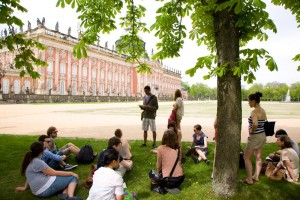
Spring term’s Berlin architecture class took a trip to Potsdam on April 29th with the aim of exploring Frederick the Great’s favoured place of residence, Sanssouci, which means “without worry”.The architecture class has so far dealt with various museums located in Berlin’s city center and their historical significance — how the architectural design as well as their respective reconstructions or restorations are loaded with socio-political meaning, and notably, how these institutions were major projects for monarchs who reigned at the time of their establishment and were aimed toward the patronage of the general public.
In this sense, Sanssouci Park is of a different nature, where most constructions were to the varied tastes and envisaged utility of members of the royal family.
The entrance to the park is a tree-filled long avenue which leads to the Neues Palais. The Palace was built under the rule of Frederick the Great, and the design was tailored to his preference for baroque architecture.
The painted facade which mimics red brick is punctuated by pilasters that run parallel in position to the sculptures which stand around the Palace. In front of the Palace is a spacious lawn with pathways leading to other notable locations around the park. The view of the Palace from afar is marked by a dome at the center that has pargeted garland-like ornaments, which contributes to the Palace’s imposing stance.
Opposite the Palace itself are the Communs which currently house the faculty of Philosophy of the University of Potsdam. Sanssouci Park had previously been granted status as a United Nations World Heritage site, and it is quite interesting to find what was once solid ground exclusive to royalty now open to a general public eager to explore (whether consciously or not) architectural manifestations of political power.
A bit farther from the Neues Palais are Schloss Charlottenhof and the Roman Baths, which in comparison to the New Palace’s baroque style are rendered in classical style, primarily based on designs by Karl Friedrich Schinkel, the same architect who handled the location planning, design and construction of Berlin’s Altes Museum.
One might be tempted to claim that the Charlottenhof manor is dwarfed by the Altes Museum’s majestic colonnade, but Schinkel, being the genius architect, had succeeded in creating a rustic neoclassical structure which is both reminiscent of Italian villas and suited for an idyllic royal summer residence. The architectural design also achieves a subtle harmony with the greenery that surrounds it, quite unlike the garden in front of the Neues Palais.
Though the manor itself was closed for restoration, the painted facade of the entrance offered much to interest visitors—allusive of Renaissance frescoes, the entrance is in fact a painted genealogy of the royal family. Similarly, the Roman Baths features a pastiche of classical elements, marked by Bachants, the companions of the wine god, Bacchus. Initially planned by Schinkel, a student of his, Ludwig Persius took over the project after his death.
Leading up to the Sanssouci Palace, the group passed by the incredibly-golden Chinese house, which served as a garden pavilion at the time of Frederick the Great’s residence in Sanssouci. The design itself is more rococo than ‘Chinese’, decorated by one figure with a parasol on top of the roof.
Sanssouci Palace sits on top of a hill to which one must walk up a wide central staircase, past the Palace’s multi-leveled vineyard. The vineyard is well-maintained with small trees and bushes trimmed each to a conic shape. The facade of the Palace facing the vineyard is clearly rococo, decorated with caryatids, sculptural female figures which also serve as pillars of structures. In the center of the facade is the name of the Palace “Sans Souci.”
Going around, one finds the segmented semi-circular colonnade of Corinthian columns which are quite reminiscent of pergolas from simpler Italian villas. The facade of the Palace that faces the colonnade is no longer decorated with sculpted figures and instead has pilasters with Corinthian capitals. Sanssouci is famously known as Frederick the Great’s place of refuge owing to his intense dislike for the Berlin City Palace. Similarly, it is a nice escape for Berliners wearied by the urban landscape.
Is it nostalgia for the days of kings or fascination for an inaccessible grandeur that makes a trip to Potsdam enticing? It is difficult to say that all those who walk through the gates of Sanssouci Park come with a critical approach to a symbolic preservation of Germany’s monarchical past, particularly on the rare occasion of a worry-free Sunday blessed with good weather.
by April Matias (2nd year BA, Philippines)
